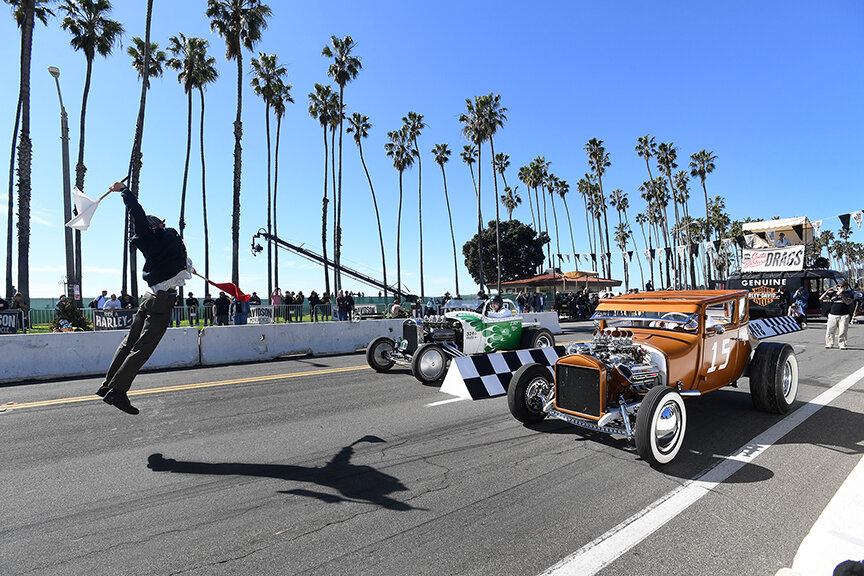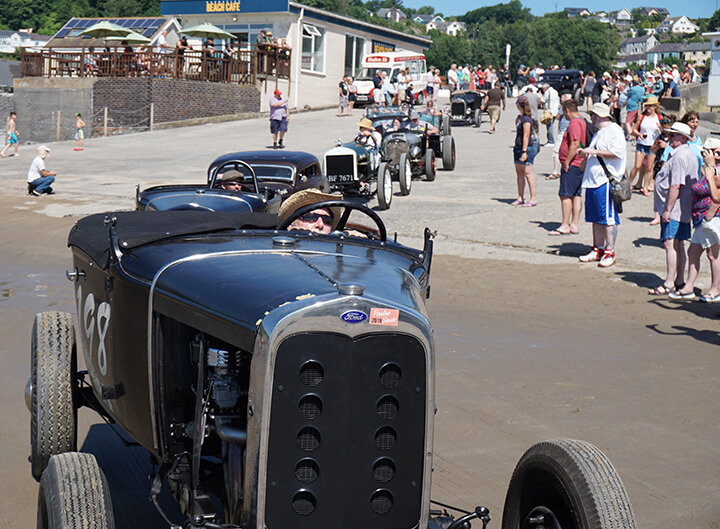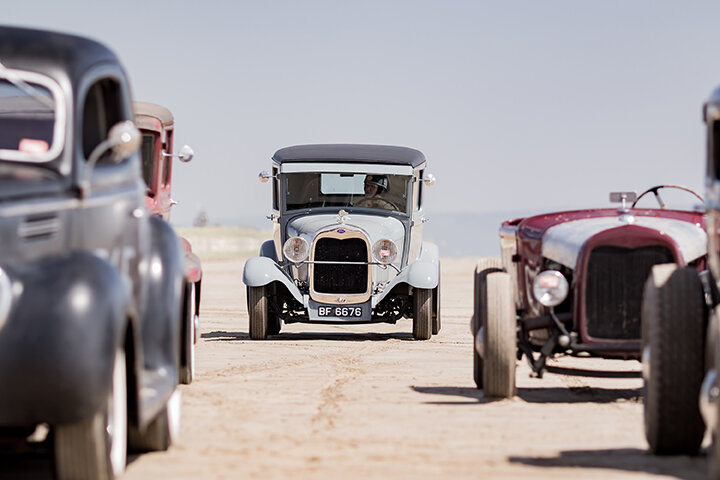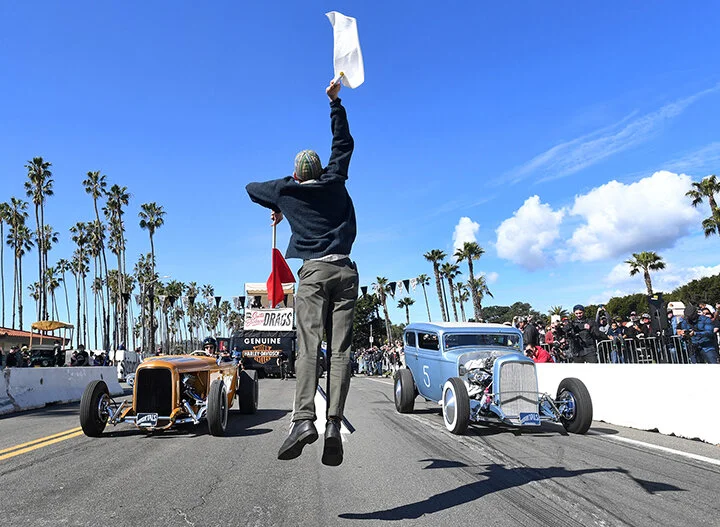Hot Rod Racing at the Beach
May 2020 • By Tony Thacker with Mike Herman, HandHFlatheads.com
Photos by Debbie Davis, Marc Gewertz, Keith Harman, David Steele and Tony Thacker




Beach racing began at Daytona/Ormond Beach, Florida, in 1903 when wealthy vacationers raced the 500 feet wide, 27-mile long beach. The first official land speed record was set there by Fred Marriott in the Stanley Rocket steam car on January 26, 1906 at 127.66 mph. Further north, a similar scene developed at Cape May, NJ, that included a memorable one-mile thrash with Louis Chevrolet and Henry Ford. Cape May was regarded as the ‘finest racing beach’ in the world.
In 1919, Sir Malcolm Campbell set a land speed record at 146.16 mph on a long stretch of sand at Pendine in Wales. That same year, the Danes began beach racing at Fanø, a small island in the North Sea.






Unfortunately, as speeds increased beach racing became too dangerous and the land speed action moved to the relative safety of the Bonneville Salt Flats, UT. Fast forward to 2012 when Mel Stultz and fellow members of the re-formed ‘Oilers’ motorcycle club conceived The Race of Gentlemen (TROG). TROG, like all fledgling events had some hiccups but it reflected a desire in bikers and hot rodders for simple events without a lot of rules. What TROG does have is Sara Francello who is the most energetic flag starter ever.
Meanwhile, in the UK, Neil Fretwell and fellow members of the Vintage Hot Rod Association (VHRA) hosted their first ever Hot Rod Races on the hallowed Pendine Sands. One hundred pre-’49 American-based hot rods and customs competed in a speed trial.
Pendine can get a little rough and the tide can have an effect, as it does at all beaches, but speeds for the fast cars have now topped 120 mph resulting in the need for roll bars and harnesses in cars that exceed 90 mph. Cars that exceed 100 mph must have a roll cage and a 5-point harness. There was some dissent when these rules were initiated but as the sign says: Motor Racing is Dangerous.
Racing returned to the beach in Denmark in 2016 with an event called the Rømø Motor Festival that honors and commemorates the history of the Fanø races. Lakolk beach racing began quietly with just 40 entries but each year the event has grown to around 100 racecars from 11 countries.
Back in the US, in 2017, Stultz and then partner Bobby Green of OldCrowSpeedShop.com, decided to try their increasingly successful formula on the west coast with an event at Pismo Beach, CA, where folks have been driving on the sand and the adjacent Oceano Dunes State Vehicular Recreation Area since the auto was invented. Pismo is generally regarded as the birthplace of the dune buggy. Unfortunately, the California Coastal Commission is no friend of duners and in 2019 released a report promising to end off-highway use of the dunes and the last place in California where you can drive on the beach. According to Green, the Commission and indeed California State made life very difficult for the organizers and even though the city of Pimso welcomed the tourist dollars poor weather and beach conditions precluded another event.





Hot rodders are not easily deterred and in March 2019 TROG succeed in hosting an exceptional drag race on the streets of Santa Barbara, CA, the birthplace of organized drag racing at Goleta Airport in 1949. The Santa Barbara Drag Races ran along a closed-off Cabrillo Boulevard right in front of the Hilton Santa Barbara Beachfront Resort albeit around a slight curve. Enjoying great weather drag racing on the streets was a huge success.
The AmericanHotRodFoundation.com (AHRF) has sponsored TROG since 2016 and according to Executive Director David Steele, “TROG is essentially a live version of the AHRF where you can meet the heroes of our hobby and enjoy the sport much as they did in the formative years. It’s a step back in time to something fun, frivolous and fast.”





Another beach event popped up in 2018 at Bridlington on the northeast coast of England. ‘Race The Waves,’ presented by Paul Garbutt of Backfire Promotions and members of the ‘Oily Tykes’ was a very low-key, almost invite-only event that featured just four hours of side-by-side drag racing over 1/8-mile. Race The Waves has now grown to embrace The Bridlington Weekend of Motoring and a Steampunk Festival and is described as a ‘Retro Theater of Auto-motion.’ The best part of the event is the rules as their web site says: ‘RULES: there are no rules.’
Yet another new event popped up on the beach-racing calendar in 2019. The Normandy Beach Race was held on the Plage de Ouistreham or Beach of Ouistreham better known as Sword beach during the Normandy landings. The mayor of Ouistreham, Romain Bail, was apparently wholeheartedly behind the event and welcomed the racers with open arms and told the police, “No tickets.” Apparently, it was another successful invasion.





While beach racing is an international phenom of the hot rod scene it remains relatively small and confined to mostly pre-’49 vehicles with flathead Fords or early ohv engines. Mike Herman of HandHFlatheads.com said, “It’s not a huge group but it’s a group loyal to the Ford flathead and as such we try to support them in any way we can. We regularly ship parts and even complete engines to Europe.”
For up to date event information contact these organizers.
Event Contacts:
Bridlington: BackfirePromotions.com
Normandy: facebook.com/normandybeachrace/
Pendine: vhra.co.uk
Rømø: RomoMotorFestival.dk
TROG: TheRaceofGentlemen.com






